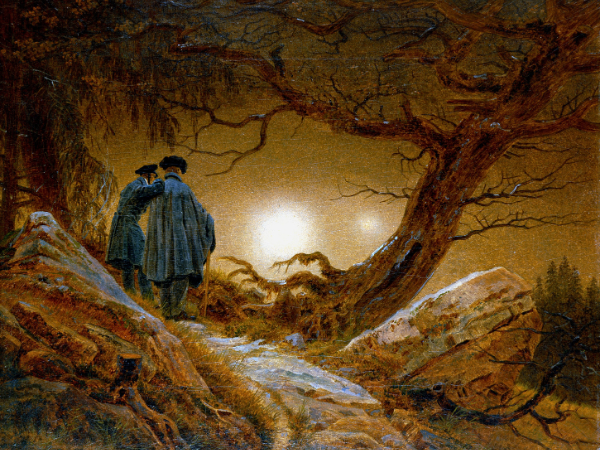Caspar David Friedrich, one of the most influential painters of the Romantic era, continues to captivate audiences centuries after his death. His landscapes, filled with symbolism and emotion, speak to modern viewers who seek meaning in nature and art. The renewed interest in his work highlights how Romanticism’s ideals remain relevant in today’s world.
Who Was Caspar David Friedrich?
Caspar David Friedrich (1774–1840) was a German Romantic painter known for his evocative landscapes that combined natural beauty with deep symbolism. His art often placed solitary figures against vast, dramatic backdrops.
- Born in Greifswald, Pomerania (now Germany)
- Studied art in Copenhagen before settling in Dresden
- Famous works include Wanderer Above the Sea of Fog and Monk by the Sea
- Central figure of German Romanticism
- Known for using the Rückenfigur (figures seen from behind)
Friedrich’s life was marked by personal tragedy, which shaped his contemplative style. His paintings invite viewers to reflect on humanity’s place in the universe.
Romanticism and Its Core Values
Romanticism was more than an art movement—it was a cultural shift that emphasized emotion, individuality, and the sublime power of nature. Friedrich embodied these ideals in his work.
- Celebration of nature’s beauty and mystery
- Emphasis on personal emotion and spirituality
- Rejection of strict classical rules in art
- Use of symbolism to convey deeper meaning
- Exploration of the human relationship with the infinite
These values resonate today as people seek authenticity and connection in an increasingly technological world. Friedrich’s art reminds us of the enduring power of emotion and imagination.
The Power of Nature in Friedrich’s Paintings
Nature was not just a backdrop for Friedrich—it was the central subject. His landscapes conveyed awe, mystery, and transcendence.
- Vast skies and dramatic horizons
- Mountains, seas, and forests as symbols of the sublime
- Use of light and shadow to evoke spirituality
- Lonely figures dwarfed by natural surroundings
- Seasonal changes reflecting life’s cycles
Through these elements, Friedrich portrayed nature as both beautiful and overwhelming, a force that inspires humility and wonder.
Symbolism and Spirituality in His Work
Friedrich’s paintings often carried symbolic meanings that went beyond the visible landscape. His art reflected spiritual and philosophical ideas.
- Gothic ruins symbolizing the passage of time
- Crosses and churches representing faith
- Fog and mist suggesting mystery and uncertainty
- Sunsets and dawns as metaphors for life and death
- Figures gazing outward as symbols of contemplation
This symbolic depth makes his work timeless, allowing viewers to interpret and connect with it on personal levels.
Why Friedrich Fell Out of Favor
Despite his brilliance, Friedrich’s reputation declined after his death. His style was overshadowed by new artistic movements.
- Rise of Realism and Impressionism in the 19th century
- Association of his art with German nationalism in later years
- Limited recognition outside Germany during his lifetime
- Changing tastes in art that favored modernity
- His reclusive personality limiting public exposure
For decades, Friedrich was nearly forgotten, but the 20th century brought a revival of interest in his visionary art.
The Modern Rediscovery of Friedrich
Today, Friedrich is celebrated as a pioneer of Romanticism whose influence extends far beyond his era. Exhibitions and scholarship have restored his reputation.
- Renewed interest in Romantic art in the 20th century
- Major retrospectives in European museums
- Influence on modern artists, filmmakers, and photographers
- Recognition of his role in shaping landscape painting
- Global appreciation of his most iconic works
This rediscovery shows how art can transcend time, finding new audiences in different cultural contexts.
Friedrich’s Influence on Contemporary Culture
Friedrich’s imagery continues to inspire artists, writers, and even popular media. His themes of solitude and reflection remain strikingly modern.
- Inspiration for contemporary painters and photographers
- Influence on film directors exploring mood and atmosphere
- References in literature and poetry
- Use of his imagery in album covers and digital art
- Continued academic study of his symbolism and philosophy
His ability to blend emotion, nature, and spirituality ensures his relevance in today’s creative world.
Why His Appeal Endures Today
Friedrich’s art speaks to universal human experiences—wonder, solitude, and the search for meaning. In a fast-paced world, his paintings encourage reflection.
- Timeless themes of life, death, and transcendence
- Emotional depth that resonates across generations
- Visual beauty that captures the imagination
- Relevance in discussions about nature and the environment
- A reminder of the importance of contemplation in modern life
Ultimately, Friedrich’s timeless appeal lies in his ability to connect the human soul with the vastness of nature, offering both comfort and inspiration.




